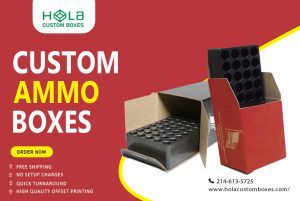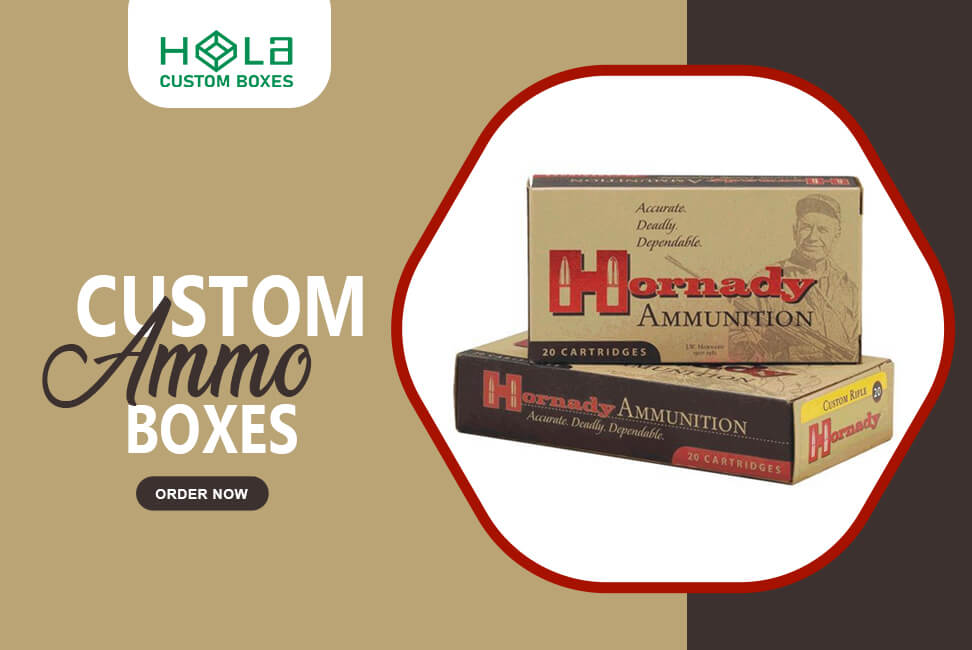Custom cardboard ammunition packaging represents a significant investment for manufacturers and distributors in the firearms industry. Production costs can range from minimal to substantial, depending on various critical factors. Understanding these elements helps businesses make informed decisions while maintaining their profit margins. Each component, from material selection to design complexity, is essential in the final cost structure. A thorough examination of these factors reveals opportunities for optimization and cost efficiency.
Main Points
- Basic ammo box costs range from $0.50 to $1.00 per unit, with bulk orders reducing prices to $0.30 per unit.
- Digital printing expenses for custom packaging typically cost between $50 to $200 per thousand units printed.
- Material selection impacts costs significantly, with standard paperboard being most economical at approximately $0.50 per unit.
- Complex designs with multiple pieces and custom shapes can double production costs compared to simple one-piece configurations.
- Bulk ordering provides substantial savings through reduced material costs and more efficient production processes.
Understanding Basic Cost Components of Ammo Box Production


Custom cardboard ammunition packaging production involves several key cost components that impact the final price point.
Custom packaging costs range from $0.25 to $10 per unit, primarily influenced by design complexity and material choice. Essential ammo packaging boxes cost $0.50 per unit, while intricate designs cost $1.00.
Printing costs typically range from $50 to $200 per thousand units. Manufacturers can reduce overall expenses by ordering in larger quantities, with per-unit costs decreasing from $0.50 to $0.30 when ordering in bulk.
Customization requirements, size, and shape complexity further affect production expenses.
Material Selection and Price Considerations
Material selection is the primary factor driving the cost of custom ammunition packaging, with paperboard emerging as the most economical choice, at approximately $0.50 per unit for basic designs.
While thicker cardboard offers enhanced durability, it increases production costs proportionally. Custom packaging solutions incorporating specialized die-cuts or perforations add complexity and expense to manufacturing processes.
Alternative eco-friendly materials like plastic or metal are more expensive than traditional cardboard.
Companies operating within a strict budget can minimize expenses by selecting thinner paperboard and utilizing pre-existing designs. This makes durable materials more cost-effective for large-scale production runs. Opting for custom stationery boxes can also enhance product appeal while remaining budget-friendly.
Design Complexity and Its Impact on Pricing
Design complexity is a critical factor influencing final pricing structures when examining custom ammunition packaging costs.
Simple one-piece cardboard ammo boxes typically cost around $0.50 per unit, while multi-piece designs can double that expense to $1.00 per unit.
Intricate designs incorporating spot colors, unique die shapes, and custom perforations require additional resources and printing methods, further escalating production costs.
Budget considerations must account for complex packaging designs’ time and labor demands.
Understanding these pricing implications helps manufacturers accurately estimate the cost of custom ammunition packaging while balancing design requirements with financial constraints.
Printing Methods and Associated Expenses
Beyond design complexity, printing methods represent a significant cost component in custom ammunition packaging production.
Digital printing emerges as the most economical choice for custom cardboard ammo packaging, offering reduced setup and production costs compared to offset printing alternatives.
Key factors affecting printing prices include:
- Production volume, with bulk orders typically ranging from $50-$200 per thousand units
- Selected printing method and associated setup costs
- Additional features beyond basic machine setup and ink requirements
Understanding these cost elements enables manufacturers to make informed decisions, often leading to substantial savings by choosing less expensive printing options while maintaining quality standards.
Quantity Breakdowns and Bulk Order Benefits
Quantity considerations are pivotal in determining the final cost of custom cardboard ammunition packaging.
When ordering custom packaging, bulk orders markedly reduce per-unit costs, with cardboard ammo boxes dropping from $0.50 to $0.30 per unit when scaling from 100 to 10,000 pieces.
While minimum order quantities may initially seem challenging, they enable substantial cost savings through reduced material and shipping costs.
Strategic planning of order quantities also supports consistent brand image and operational efficiency.
Companies can optimize expenses by choosing simpler designs for bulk orders and balancing design complexity with production costs. Additionally, customization options allow businesses to tailor their packaging to specific needs while maximizing efficiency and cost-effectiveness.
Customization Options and Cost Variables
The selection of customization options represents a notable factor in determining the overall cost of cardboard ammunition packaging. Cost variables fluctuate based on design complexity and packaging materials chosen, with paperboard remaining the most economical option for cardboard ammo boxes.
Key factors affecting production costs include:
- Printing methods, where digital printing offers cost-effective solutions compared to advanced techniques.
- Design complexity, including specialized die shapes and perforations requiring additional manufacturing steps.
- Quantity ordered, with larger volumes notably reducing per-unit costs from $0.50 to $0.30 for orders exceeding 10,000 units.
Quality Control Measures and Their Price Effects
Since maintaining high standards in ammunition packaging is vital for safety and compliance, quality control measures considerably impact the final cost of custom cardboard boxes. These measures include thorough inspections, sample runs, and rigorous quality assurance processes throughout production stages.
While initial expenses increase due to prepress costs, additional labor, and specialized equipment, this investment typically yields long-term benefits.
Extensive quality control measures enhance the durability and precision of final products. Although production costs may be higher upfront, improved customer satisfaction and reduced product returns often offset these expenses, making quality control a vital component of custom packaging manufacturing.
Shipping and Handling Cost Factors
Beyond production quality, shipping and handling expenses represent a significant portion of total packaging costs. The relationship between custom packaging dimensions, weight, and shipping fees directly impacts overall expenses. Distance from manufacturer to destination further influences these costs.
Key factors affecting shipping expenses include:
- Material selection – lightweight paperboard reduces transport costs while maintaining protective measures
- Order volume – bulk orders decrease per-unit shipping costs through economies of scale
- Distance and handling requirements – longer transport routes and special handling fees increase total expenses
Companies can optimize costs by carefully considering these elements when planning cardboard ammo packaging logistics.
Market Research and Competitive Pricing Analysis
Understanding market dynamics through extensive research reveals critical insights into custom cardboard ammo packaging costs.
Market research indicates average costs range from $0.25 to $1.80 per unit, influenced by design complexity and material selection.
Competitive pricing analysis demonstrates significant savings through bulk ordering, with the price per unit dropping from $0.50 to $0.30 for larger quantities.
Leading brands maintain durability standards while offering customization options at competitive price points.
Industry trends show increasing demand for eco-friendly packaging, affecting consumer purchasing decisions.
Manufacturers offering cardboard ammo boxes with tailored solutions command premium pricing due to perceived value in the marketplace.
Cost-Saving Strategies for Custom Ammo Packaging
While manufacturers often face substantial costs in custom ammunition packaging, several proven strategies can significantly reduce expenses without compromising quality.
Implementing cost-saving strategies requires careful consideration of materials, production methods, and design elements.
- Bulk ordering cardboard ammo boxes in quantities of 10,000 or more can reduce unit costs by up to 40%, maximizing cost efficiency.
- Utilizing digital printing instead of traditional methods, simplifying designs, and limiting color usage markedly decreases printing expenses.
- Selecting standard sizes and thinner paperboard materials maintains necessary durability while reducing material costs in custom packaging production.
Conclusion
Successful custom cardboard ammo packaging production hinges on balancing quality with cost-effectiveness. Manufacturers can achieve significant savings through strategic material selection, design optimization, and bulk ordering while maintaining product integrity. Understanding market dynamics and implementing quality control measures guarantees competitive pricing. By carefully considering these factors, businesses can develop sustainable packaging solutions that meet budget constraints and customer expectations.

